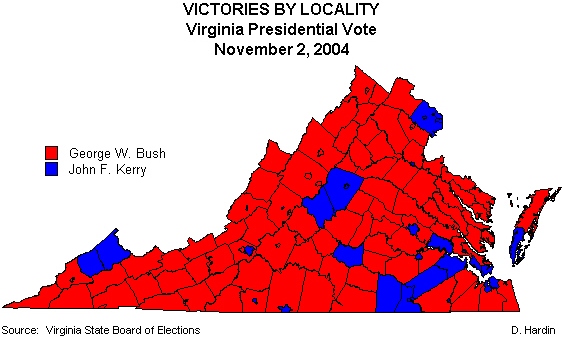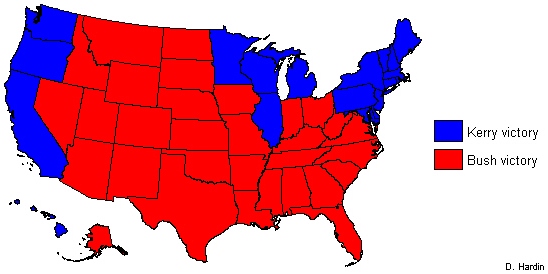ELECTIONS
2004

VIRGINIA ELECTIONS
PRESIDENTIAL ELECTION



DEMOCRATIC PRESIDENTIAL PRIMARY







Victory Margins (by locality)


NATIONAL PRESIDENTIAL
ELECTION

Electoral
Vote Balance:
Needed
to win - 270
Bush
- 286
Kerry
- 252

Victories
by County:
Two Perspectives
USA
Today

Robert
Vanderbei's "Purple America"
http://www.princeton.edu/~rvdb/JAVA/election2004/

Sticking My Neck Out:
My Prediction for the
Presidential Election
(written November 1, 2004)
Well, here it is again: my best guess as to how this election is going to turn out. Based solely on the trends in the polls and the Redskins' loss, I am predicting that John Kerry will win. This assumes that Kerry carries all of the Northeast (including Pennsylvania), the Upper Midwest (excluding Indiana), the Pacific states (excluding Alaska), the Southern Rockies (Colorado might be a reach), and Florida (see the maps below). If my prediction holds true, Kerry will win
with 320 Electoral College votes to George Bush's 218. In a normal election cycle under normal conditions, the fact that Bush is not polling above fifty percent should be enough to seal his fate. The issue that is keeping Bush in the race is his contention that he is a "wartime" President and -- as Lincoln put it -- you "don't change horse in the middle of the stream." This has been the most extensively polled election in the history of mankind and still we can't identify a clear leader. I maintain that the registered voter polls will turn out to be more accurate, simply because of the millions of newly-registered voters this time around. In the end, it's all about turn out and in that, the youth vote will be key. If the 18-24 age group comes out and votes, Kerry will win by an indisputable margin. Unfortunately, that age group traditionally is least likely to vote, so it will remain the great unknown factor of the 2004 election until the dust settles. Will we know who the next President will be by the end of the day on November 2? I think so. Whoever takes Florida and either Ohio or Pennsylvania probably will win. Will Kerry take Virginia? I will be surprised if there is a Kerry victory in Virginia.

How
Did I Do?:
Prediction
Accuracy
Once
again, I missed by four states. . .I really should give this up.
The tracking polls were generally dismal predictors of the outcome of
the
election. My suspicion is that the polls were skewed toward urban
and suburban areas and women. That would account for the
pollsters
missing the single largest deciding group in this election: rural
and exurban, white, predominantly male, conservative evangelical
Christians.
Either that or people were lying about their intention to vote for
Bush.
Karl Rove should be applauded for once again identifying the key state
in this election. Their ground operation targeted the right
people
in Ohio and the Mayor of San Franscisco gave them the perfect
hot-button
issue: gay "marriage." Such "moral" issues drove
evangelical
Christians to the polls in unprecedented numbers, accounting for Bush's
multi-million popular vote margin. In this case, high voter
turnout
hurt rather than helped Democrats. Of course, Bush's success in
promoting
himself as a "War-time President" made Kerry's challenge an uphill
battle
from the start, continuing the streak of victories for incumbent
Commanders-in-Chief.
Tracking Polls

The Track Record:
Presidential Preference Patterns
in 1992, 1996, and 2000

















